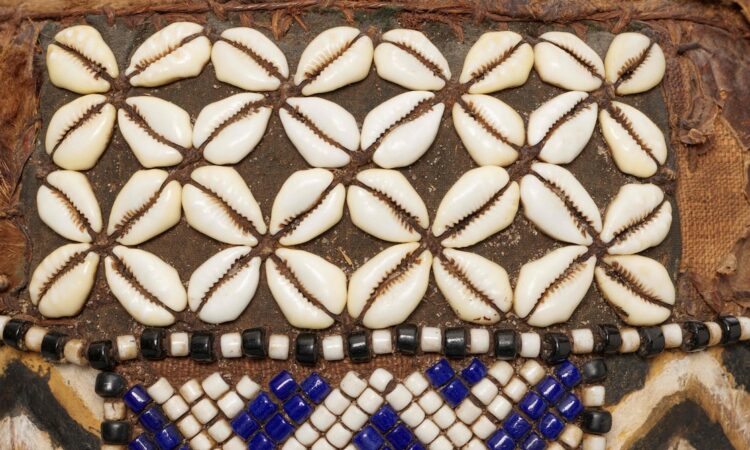
It starts on the bottom of the ocean, when larvae hatched from the eggs of a sea snail begin to form shells.
By <a href=”https://www.artic.edu/authors/45/elizabeth-benge” rel=”author”>Elizabeth Benge</a>
Each snail larva continues to build its shell until it reaches maturity, using it for anywhere from two to ten years, depending on the size. With the death of its maker, the empty shell joins countless others—though it sometimes finds a second life in the hands of humans.
The arts of Africa collection contains some 40 works that incorporate cowrie shells or even imitations of them. These shells are one of the most widespread and longest lasting currencies in the world. Once home to marine gastropod mollusks in the family Cypraeidae—there are close to 200 species—these shells were acquired in abundance in the Indian and Pacific Oceans.
Examples of monetaria annulus
Unlike many shells which are created from the inside out, cowrie shells are created from the outside in, giving the surface its valued smooth and glossy surface.
The small sizes of these shells, along with their durable but lightweight surfaces, made them easily portable and thus perfect as circulating currency. Their weights varied only slightly so monetary value was calculated by quantity. The shiny white surfaces held a visual attractiveness, and unlike modern coins and paper money, cowrie shells were almost impossible to counterfeit. (It is understandably harder for people to replicate the natural world than something manufactured originally by human hands).
Their value was in part due to the efforts required to harvest and transport them as they are not native to many of the people who used them. But their cultural values also varied by region and in many parts of Africa they held positive associations related to their natural marine origins, the white color of the shell, and their connection to currency. Cowries adorn figures, masks, and garments; while some objects feature a few carefully placed shells, others are covered in them.
Many artworks in our collection incorporate the specific species of sea snail known as Monetaria moneta and Monetaria annulus, although other types of gastropoda (snails and conches) were used in similar artistic contexts, such as a newly acquired Maasai necklace with a conus shell design (below).
Maasai
The import of these cowrie shells to areas of West Africa rose exponentially from the late 15th century in connection to European trade in ivory, slaves, gold, and later palm oil. Their numbers grew from the 16th to 19th century, during which time billions of cowrie shells found their way to Africa, especially in regions of modern Ghana, Benin, and Nigeria.
masks from the Kuba Kingdom
Located in the heart of modern-day Democratic Republic of the Congo, the Kuba Kingdom flourished between the 17th and 19th centuries and still exists today. Kuba masks beautifully incorporate cowries in their elaborate designs. The forms and materials work to symbolize and legitimize the royal family members that would often dance these masks together in reenactments related to the foundation of the kingdom. Very prominently featured, the cowrie shells are arranged in complex and time-consuming patterns, their shiny white surfaces enhancing the decorative patterns of each object and symbolizing power and wealth.
Cowries also appear whole or as carved depictions on objects meant to bring good fortune and celebrate fertility. They are seen on ibeji figures of the Yoruba in Nigeria or on the back of the head of a Luluwa mother-and-child figure from the Democratic Republic of the Congo.
A gold Asante pectoral disk from Ghana is an example of the radiant regalia that marked Asante life since the kingdom’s inception in the 18th century. The design includes purposely selected symbols referencing social status and wealth including cowrie shells in a number of different places.
Cowrie shells were also used in certain religious rituals, especially in West Africa, and their origin from the natural world held particular importance in these contexts. The white color of the shells was significant in these settings in part due to its close association with the realm of spirits, including ancestors, and many religious specialists wore white clothing or adorned themselves with regalia featuring the conveniently white cowrie shells. The white of the shell is further associated with positive ideas of purity, health, growth, and insight.
The shells were part of divination sets where they also appear decoratively, such as carved around the rim of this tray. Additionally, containers were made to hold a diviner’s implements, which included cowrie shells and other small accessories.
Yoruba
Though cowries appear in decorative contexts in ancient Egypt, they were not used as currency in the same way they were in areas of West Africa and coastal parts of East Africa and instead appear more abstracted as imitations in precious metals, stone, faience, and glass. Beads or amulets in the shape of cowries are termed ‘cowroids’ and were a favorite in ancient Egypt from the Middle Kingdom (about 2055–1650 BCE) on.
Ancient Egyptian
These cowroids functioned as seals and often depicted hieroglyphs or other designs on the underside (where the aperture of the shell would have normally appeared).
For millennia, the sea has been a source of life and sustenance for humankind, and as these small marine mollusks show us, a source of potent wealth, both material and spiritual. The shell of this animal that lived in the realm of water found a whole other life on land. It makes one consider if perhaps death itself is just another beginning.
—Elizabeth Benge, collection manager, Arts of Africa and Arts of the Ancient Mediterranean and Byzantium



